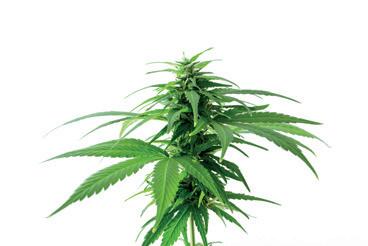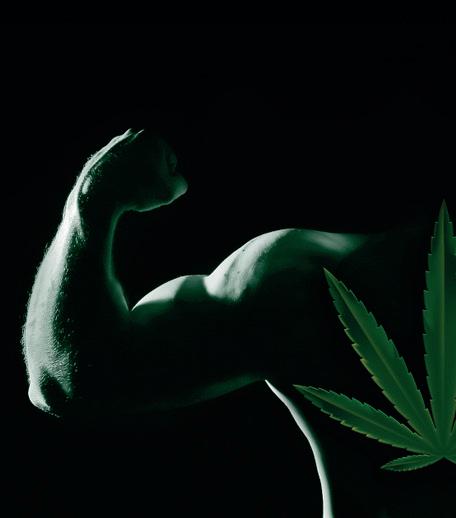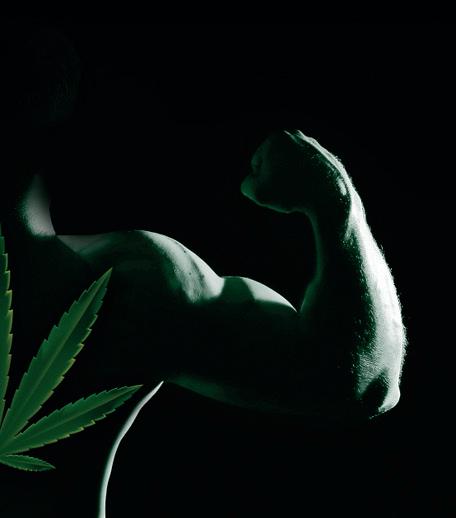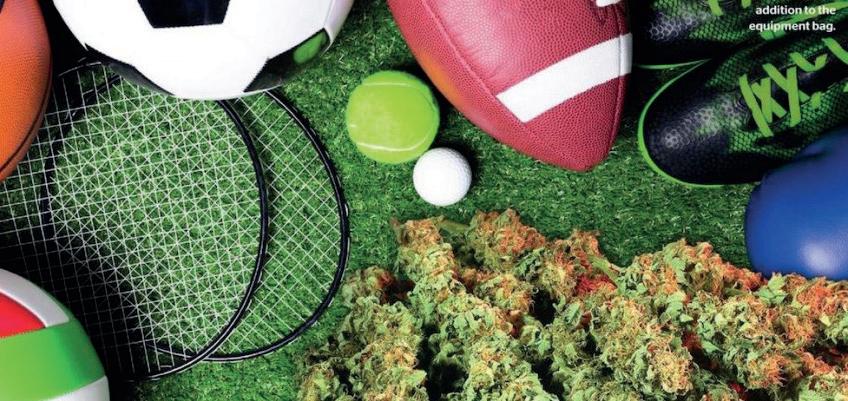
8 minute read
Myths and realities about the use of cannabis as an ally in sport
LET’S TALK ABOUT CANNABIS
● The benefits and safety of cannabis use and the improvement in athletes’ physical performance are not supported by good quality scientific studies, despite the anecdotal and empirical information that has been disseminated.
Advertisement
● Amid speculation of possible beneficial applications, the effects of cannabis and its two most abundant components, delta-9tetrahydrocannabinol (THC) and cannabidiol (CBD), remain uninvestigated in depth in the context of sports medicine.
● This limitation in clinical research is directly related to the prohibition of the cannabis plant and all existing regulatory barriers.
The Cannabis sativa plant is made up of more than 500 chemical compounds, including THC and CBD, which are the most abundant and studied cannabinoids in humans. These cannabinoids have their own characteristics and specific therapeutic effects. Thus, for example, low-dose THC has been shown to be useful for the control of chronic neuropathic pain, reduce nausea and vomiting secondary to chemotherapy and increase appetite in patients with HIV and cancer, among others. For its part, CBD has been shown to have anti-inflammatory, anxiolytic (low anxiety levels), neuroprotective properties, and an important control in seizures of patients with refractory epilepsies. But, in sports, what is known about the effects of cannabinoids? Dr. Mafer Arboleda, an expert in medicinal cannabis, clarifies it for us.

How prevalent is cannabis use among athletes?
Currently, it is increasingly common to hear that cannabinoids serve to potentiate physical performance in athletes, recover injured muscles and tissues, improve anxiety and sleep quality of athletes, etc. Even the issue of cannabis in sports has generated significant controversy, to the point that the World Anti-Doping Agency (WADA), in 2018, decided to remove CBD from the list of prohibited substances1 for use in competitions. Not so for THC, where concentrations greater than 150 ng/ml in urine, continue to represent a violation of anti-doping rules. However, despite all this anecdotal and empirical information that has been disseminated, it has not yet been proven, nor is it supported by good quality clinical research, that the use of cannabinoids, both THC and CBD, improve athletic performance or has any beneficial effect on injured tissues in humans, even though historically it has been consumed by athletes frequently.
Despite the lack of clinical research supporting the use of cannabinoids in sport, the misconception, until now, that it improves athletic performance has led to an increase in their consumption to a large extent since the early 2000s. A systematic review of the literature found that out of 46,000 athletes of different ages and playing various sports, 23% had used some form of cannabis in the past year.2 This was generated by the idea of the possible benefits that cannabinoids can bring them in terms of sleep quality, anxiety and mood control, muscle relaxant effect, exercise recovery, pain control, recovery after a concussion, stress, euphoria, and improvement in muscle and joint inflammation.
Moreover, a survey conducted in 2019 showed that, of 1,161 participants, 26% reported current cannabis use and, of these, 63% reported exercising at least 5-7 times a week. More than 50% of these athletes reported having chronic pain. 3
What is known about the effect of THC in the context of the athlete?
At the moment we know that the results of clinical research in humans do not support the benefits of consuming THC in sports, on the contrary, the few studies conducted (which were carried out more than 30 years ago), conclude that physical performance is hindered by reducing endurance, increasing heart and respiratory rate, reduce the ability to maintain physical effort and capacity and generate increased myocardial oxygen demand.4 Predominantly an ergolytic effect (detrimental effect on physical performance) and a higher degree of tachycardia, orthostatic hypotension, and accelerated fatigue are shown.
The methodology of many of these studies is limited and over the years there have been multiple changes in THC consumption. Today, much higher concentrations of THC are consumed (6-10 times more than 35-40 years ago), delivery methods have evolved and ways of measuring physical performance have also advanced.
An athlete who consumes THC before exercise can be harmed and endanger his/her health, and that of his/her peers and bystanders. Cannabis should not be considered an ergogenic substance (which refers to performance-enhancing substances), and doping control tests should take into account its social and health implication and not really the performance activity.
“The validity of THC’s effect on physical performance is still unknown, as huge gaps remain since human clinical research; studies are needed that use appropriate tools to objectively measure exercise capacity and performance in humans,” says Dr. Mafer Arboleda.

And about CBD in sports, what evidence do you have?
With regard to CBD, the results may be promising for athletes, since in preclinical studies (animal models, mainly) anti-inflammatory, neuroprotective and analgesic effects have been observed. However, this should not yet be extrapolated to possible effects that benefit the athlete. “We still need to develop clinical studies in humans to show whether CBD really has these specific therapeutic effects for athletes,” explains Dr. Arboleda.
It is important to recognize that most of the therapeutic effects that have been proposed for CBD in sports medicine, such as improvement in sleep quality, anxiety, anti-inflammatory effect, etc., come from results of studies in animal models or from the effects of CBD in patients with specific pathologies such as social anxiety disorders, Parkinson’s disease, and post-traumatic stress disorder, among others, with results that also remain controversial and conclusions where poverty is spoken of in the quality of the evidence.
The effect of CBD on the recovery of injured musculoskeletal tissues has also been proposed, but again, it is in studies conducted in animal models and cellular tissue. Clinical research is still required, with controlled and well-designed studies, to confirm these findings on the effects of CBD on athletes. It is worth emphasizing that studies that have included CBD to determine its effect on athletes have not used objective measurement scales that show the real impact of this cannabinoid on the symptoms to which improvement is attributed after administration, such as improvement of insomnia, for example. In fact, some of these studies that “go viral” have been carried out mainly with food supplements with doses greater than 150 mg of hemp-derived CBD, which does not correspond to real medical treatments and therapies used in clinical practice with cannabinoid-based medicines.
“While many results are promising for the effect CBD can have on athletes, it is critical to conduct the best possible quality clinical research that gives us truthfully, scientifically based answers,” concludes Dr. Mafer Arboleda.

Are cannabis products used among athletes safe?
Athletes seek to be an example of health and wellbeing; This is a consequence of physical work, good nutrition, rest, and mental work. Unfortunately, trends and “fashions” marked by marketing have opened new paths to achieve social, psychological, physical, or belonging goals, through the consumption of unauthorized, unproven, and low-quality substances, putting their own health and, in some cases, their professional careers at risk.
It is very important to take into account the quality of the cannabis-derived products that are consumed, since in some countries (e.g., the United States of America) they are considered food supplements without strict quality control that demonstrates origin, components, and contaminants or even if the amount of CBD they contain really corresponds to that marked on the bottle label. As demonstrated in a study conducted in 20175, where 84 products were purchased online from 31 companies and the concentration of cannabinoids and contaminants was analyzed:

• 69% of the products had different levels of CBD than what was promoted on the label;
• And 21% contained THC (despite promoting and selling it as a CBD-only product), with some levels of THC potentially producing intoxication or cognitive compromise and being detected in anti-doping processes.
For all the above, it is essential to take care of the health of athletes and ethical and regulatory issues must be considered before recommending the use of cannabinoids in sports medicine.
Dr. Mafer Arboleda

Associate Director of Research at Santé Cannabis, a leading clinic specializing in the prescription of medical cannabis in Quebec, Canada. Anesthesiologist specialized in chronic pain and palliative care by UNAM and INCMNSZ. Medical surgeon from the Pontificia Universidad Javeriana, Bogotá. Clinical fellowship and postdoctoral studies in Supportive Care in Cancer and Medical Cannabis at McGill University, Montreal, Canada. #DrMaferArboleda #MaferCannabisMD
Sources:
Burr, Jamie & Cheung, Christian & Kasper, Andreas & Gillham, Scott & Close, Graeme. Cannabis And Athletic Performance. Sports Medicine. 2021; 51(Suppl 1):75-87. doi: 10.1007/s40279-021-01505-x
World Anti-Doping Agency. (2021, enero). WORLD ANTI-DOPING CODE INTERNATIONAL STANDARD PROHIBITED LIST.
Docter S, Khan M, Gohal C, Ravi B, Bhandari M, Gandhi R, et al. Cannabis use and sport: a systematic review. SportsHealth . 2020;12:189–99.
Zeiger JS, Silvers WS, Fleegler EM, Zeiger RS. Cannabis use in active athletes: behaviors related to subjective effects. PLoS One. 2019;14:e0218998
Bonn-Miller MO, Loflin MJE, Thomas BF, Marcu JP, Hyke T, Vandrey R. Labeling accuracy of cannabidiol extracts sold online. JAMA. 2017;318:1708-1709.










